July 12 2024 at 11:00AM
Using the SAFETY Framework to Create Psychological Safety in Project Teams
Psychological safety is the key to innovation, collaboration, and performance in fast-moving project settings. It means people can share their ideas and opinions without fear of being punished or humiliated. Project managers are responsible for creating this safe space for their teams. I’ve created the SAFETY framework to help them do this: Support, Accountability, Feedback, Empathy, Trust, and Yield. These six words summarize the main components of psychological safety for any project team. Let’s see the SAFETY framework in action in the following hypothetical scenario.
Maria, a project manager, led a team to create new software. At first, her team members were afraid to speak up or share their opinions, worrying about negative consequences. Maria used the SAFETY framework to change the team’s culture. She showed support and set clear accountability, making team members responsible for their work. Feedback and empathy made team members feel appreciated and heard, while building trust with openness and dependability improved their relationships.
One significant change happened during a brainstorming session. By listening to her team’s ideas and empowering them, Maria witnessed a boost in creativity and innovation. Team members who were previously quiet started to participate actively, leading to the creation of a novel feature for their product. This increased level of psychological safety not only enhanced team morale but also led to a better quality of work and quicker project completion. Maria’s team became a role model of how the SAFETY framework can foster success through a supportive and inclusive environment.
The SAFETY Framework for Fostering Psychological Safety in Project Teams
Support - Provide emotional and professional support to team members. This involves actively listening to their concerns, offering help, and providing resources.
- Hold regular check-ins to discuss team members' well-being.
- Offer mentorship and professional development opportunities.
- Create a supportive environment where team members feel valued and heard.
Accountability - Promote a culture of accountability where team members take responsibility for their actions without fear of blame.
- Establish clear roles and responsibilities.
- Encourage ownership of tasks and projects.
- Create a safe space for admitting mistakes and learning from them.
Feedback - Encourage open and constructive feedback. This includes both giving and receiving feedback in a respectful and non-judgmental manner.
- Implement regular feedback sessions.
- Train team members on how to give and receive constructive feedback.
- Celebrate successes and learn from failures together.
Empathy - Show empathy towards team members by understanding and sharing their feelings. This helps build a supportive and understanding team culture.
- Practice active listening and show genuine concern for team members' issues.
- Address personal and professional challenges with compassion.
- Foster an inclusive environment where diversity is respected and valued.
Trust - Build and maintain trust within the team. Trust is the foundation of psychological safety and enables open communication and collaboration.
- Be transparent in decision-making processes.
- Follow through on commitments and promises.
- Encourage collaboration and trust-building activities.
Yield - Yield to team members' ideas and suggestions, promoting a sense of ownership and empowerment. This involves valuing their input and allowing them to take the lead when appropriate.
- Encourage team members to share their ideas and opinions.
- Delegate responsibilities and allow team members to take the lead on tasks.
- Recognize and reward initiative and innovation.
The SAFETY framework provides a practical and easy-to-follow tool for project managers who want to foster psychologically safe environments. By paying attention to Support, Accountability, Feedback, Empathy, Trust, and Yield, managers can develop teams that are not only effective but also flexible and robust. The change observed in Maria’s team shows the real advantages of making psychological safety a priority, from increased creativity to better team harmony.
The SAFETY framework is not only a set of guidelines but a useful tool for any project manager who wants to create a positive team culture. The path to psychological safety is never-ending, demanding constant dedication and adjustment. However, the benefits—a driven, involved, and excellent team—are valuable. As you apply the SAFETY framework, keep in mind that building psychological safety is a joint process between you and your team. A process that will enable your team to achieve new levels of success.



